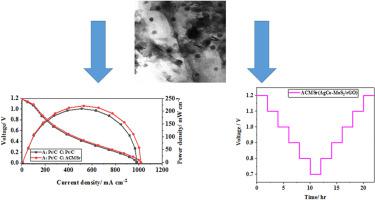当前位置:
X-MOL 学术
›
J. Power Sources
›
论文详情
Our official English website, www.x-mol.net, welcomes your feedback! (Note: you will need to create a separate account there.)
Designing and modeling fuel cells made of mixed transition metal dichalcogenide and carbon-based nanostructure electrodes for renewable energy storage
Journal of Power Sources ( IF 9.2 ) Pub Date : 2024-04-10 , DOI: 10.1016/j.jpowsour.2024.234514 Mahdi Soleimani Moghaddam , Ali Bahari , Hajar Rajaei Litkohi
Journal of Power Sources ( IF 9.2 ) Pub Date : 2024-04-10 , DOI: 10.1016/j.jpowsour.2024.234514 Mahdi Soleimani Moghaddam , Ali Bahari , Hajar Rajaei Litkohi

|
A noteworthy component in upgrading renewable energy conversion and storage device is the development of oxygen reduction reaction (ORR) electrocatalysts. Although micropore active sites sustain high ORR activity, meso-micropores play a crucial role in enhancing single-cell performance. Our breakthrough is that we prepared 0.2 mg cm of AgCo–MoS/rGO (abbreviated as ACMSr) electrocatalyst as the cathode catalyst loading and 0.2 mg cm of Pt/C as the anode catalyst loading in the fuel cell test, and as a result, achieved peak power density and maximum current density of 221 mW cm and 525.41 mA cm, respectively. Various parameters, such as relative humidity, operating temperature, amount of injected oxygen, and back pressure, affect the performance of the fuel cell. A decrease in the humidity of the cathode negatively impacts the performance of the fuel cell. At temperatures of 65–75 °C, the fuel cell's performance increased at various temperatures. The performance of the fuel cell is directly affected by the rate of injected oxygen through the amount of gas flow and indirectly by the flooding effect in the cathode and membrane humidity. These achieved data provide a suitable approach for the design and modeling of fuel cells.
中文翻译:

设计和建模由混合过渡金属二硫属化物和碳基纳米结构电极制成的用于可再生能源存储的燃料电池
升级可再生能源转换和存储装置的一个值得注意的组成部分是氧还原反应(ORR)电催化剂的开发。尽管微孔活性位点维持高 ORR 活性,但介观微孔在增强单细胞性能方面发挥着至关重要的作用。我们的突破在于,我们在燃料电池测试中制备了0.2 mg cm的AgCo–MoS/rGO(简称ACMSr)电催化剂作为阴极催化剂负载量和0.2 mg cm的Pt/C作为阳极催化剂负载量,结果,峰值功率密度和最大电流密度分别为221 mW cm和525.41 mA cm。各种参数,例如相对湿度、工作温度、注入氧气量和背压,都会影响燃料电池的性能。阴极湿度的降低会对燃料电池的性能产生负面影响。在 65–75 °C 的温度下,燃料电池的性能在不同温度下都有所提高。燃料电池的性能直接受到通过气体流量注入氧气的速率的影响,并间接受到阴极和膜湿度中的溢流效应的影响。这些获得的数据为燃料电池的设计和建模提供了合适的方法。
更新日期:2024-04-10
中文翻译:

设计和建模由混合过渡金属二硫属化物和碳基纳米结构电极制成的用于可再生能源存储的燃料电池
升级可再生能源转换和存储装置的一个值得注意的组成部分是氧还原反应(ORR)电催化剂的开发。尽管微孔活性位点维持高 ORR 活性,但介观微孔在增强单细胞性能方面发挥着至关重要的作用。我们的突破在于,我们在燃料电池测试中制备了0.2 mg cm的AgCo–MoS/rGO(简称ACMSr)电催化剂作为阴极催化剂负载量和0.2 mg cm的Pt/C作为阳极催化剂负载量,结果,峰值功率密度和最大电流密度分别为221 mW cm和525.41 mA cm。各种参数,例如相对湿度、工作温度、注入氧气量和背压,都会影响燃料电池的性能。阴极湿度的降低会对燃料电池的性能产生负面影响。在 65–75 °C 的温度下,燃料电池的性能在不同温度下都有所提高。燃料电池的性能直接受到通过气体流量注入氧气的速率的影响,并间接受到阴极和膜湿度中的溢流效应的影响。这些获得的数据为燃料电池的设计和建模提供了合适的方法。



























 京公网安备 11010802027423号
京公网安备 11010802027423号